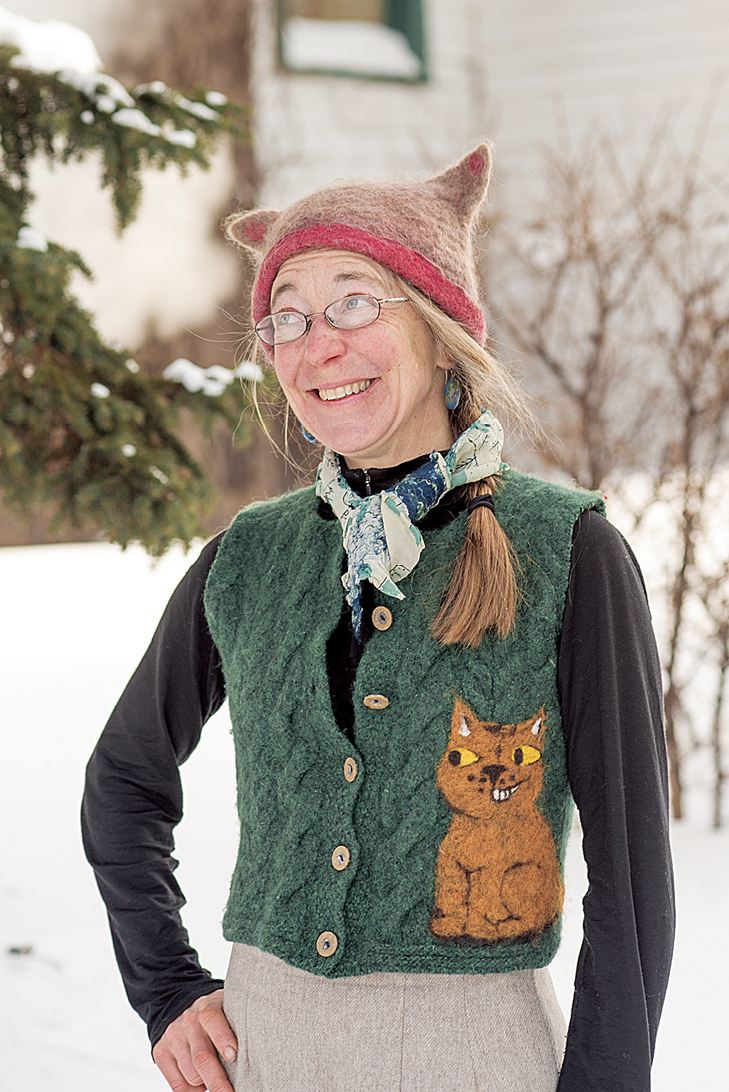It’s a long, tangled fiber that binds my desire to felt a mural to the ancient method of felting rugs. Before wool, paint was my medium of choice, working on large walls with lots of people. I organized community murals to quickly transform spaces marked by gang graffiti, an exciting and chaotic process that brought people together. I moved to Grand Marais in 2012, where there was no graffiti and adopted wool as my new favorite artistic medium. With this shift in mediums, I accepted a slower, silent, process of creating smaller works. If you know wool, you are familiar with its time-consuming process, whether it is spinning, knitting, weaving or felting.
The story of how felting was discovered expresses this well. Supposedly, while soldiers were marching to war, they filled their sandals with sheep wool. After traveling for days, sweating and compressing the wool, they discovered they had made very durable felted wool soles. I’m sure felted wool soon became saddles, hats, rugs, until today when artists are felting shoes, wedding dresses, sculptures and possibly even murals. With many crafts, there may be short cuts or time savers, but with felting, whether small or large, it is a process of patient agitation that causes the microscopic wool fibers to permanently bond to one another. This hand work, beginning with gentle rubbing and progressing to full physical exertion, cannot be rushed.
After a full year of quietly crafting with wool and covid isolation, I am scheming to safely bring people together in exciting and chaotic creativity, like painting a mural, but using wool instead. Wool, water and our hands will replace the paints and paintbrushes, with a goal of three 4-by-6-foot community-made felted murals. I wish to create an opportunity for people to gather, to be creative and to create something larger than we could do alone.
Because I am a painter, and a felter but not a rug maker, I turn to the Far East and Middle East tradition of felted rugs. Closer to home, I look to Mary Reichert, a local felter who loves to make rugs and learned traditional rug-making methods in Kyrgyzstan. In a past rug making workshop at North House Folk School with Reichert, she expressed the complexity of the symbolism often embedded in these rugs; what may look simply like patterns, is actually a living story told by the maker and becomes a blessing to the person gifted the rug. Perhaps, similar to a felted rug, the community murals were a form of storytelling, as well as a way to heal and bring beauty to a community. Similar to the painted murals, the felted murals will become a story told by the many people who participate in the making of the murals. While there’s no graffiti in Grand Marais, there is plenty to heal from after a really difficult year full of challenges and suffering, from which no one was immune.

The idea for felting murals came from a visit to my childhood neighborhood in Minneapolis destroyed by the civil unrest after the murder of George Floyd. I was utterly flattened with sadness as I witnessed so much destruction throughout the city. Feeling hopeless and helpless, I did the one thing that felt right; pull out buckets of paint and paintbrushes, gather people and paint murals.
The three felted murals will be similar to the painted murals, focused on healing, dreaming and building. Each mural filled with symbolic hearts, swallows or bees, with a word of personal importance chosen by the maker. These symbols will be made and gathered over the next four months in public workshops, online or in person. Like a traditional felted rug, a large wool base will become the home for these symbols and the living story they tell. With the help of many hands, the rugs will be felted together, a slow, physical process of gently rubbing the wool, walking on the wool, dancing on the wool and rolling the wool until it is transformed into something durable and long lasting.
Everyone will celebrate when the plywood murals in Minneapolis are taken down and businesses open up, but there is the awareness that the anger, fear, racism and divisions between people that caused the uprisings have not gone away. We continue to navigate covid, political divisions and so much more. I hope that these felted murals will become a collective voice, memory and a reminder of what challenges we have shared and survived during the last year. What we are healing from, what we are dreaming about and what we are going to change or build as we step forward.
This project is made possible through a grant from the Arrowhead Regional Arts Council and North House Folk School, Artist Development Program. Look for community drop-in workshops, a class at North House Folk School the last weekend in July and finally a ceremony celebrating the completion of the felted murals, the first week of August. For more felted projects, visit: worksinwool.com.
Elise Kyllo lives in Grand Marais and is a felting instructor and a Resident Artisan in the Artist Development Program at North House Folk School, where traditional craft is taught on the shore of Lake Superior.

